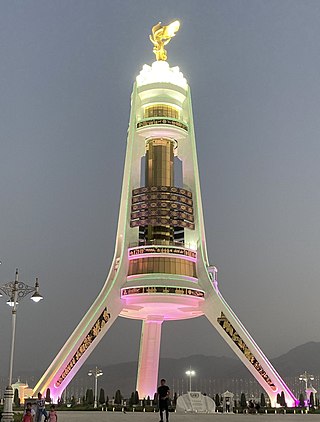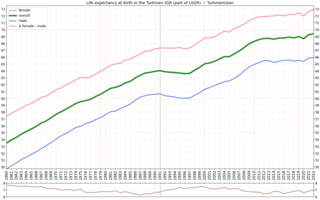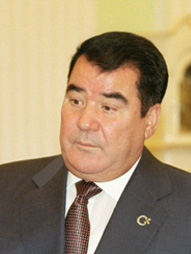
The history of Turkmenistan traditionally began with the arrival of Indo-European Iranian tribes around 2000 BC. Early tribes were nomadic or semi-nomadic due to the arid conditions of the region, preventing widespread adoption of agriculture. The steppe culture in Central Asia was an extension of a larger Eurasian series of horse cultures which spanned the entire spectrum of language families, including the Indo-Europeans and Turko-Mongol groups. Some of the known early Iranian tribes included the Massagatae, the Scythians/Sakas, and early Soghdians, who were most likely precursors of the Khwarezmians. Turkmenistan was a passing point for numerous migrations and invasions by tribes, which gravitated towards the settled regions of the south, including ancient Mesopotamia, Elam, and the Indus Valley civilization.

The politics of Turkmenistan nominally takes place in the framework of a presidential republic, whereby the President of Turkmenistan is nominally both head of state and head of government. However, as of 21 January 2023 a "national leader" was appointed who chairs an independent People's Council (viz.) with authority to amend the constitution, and who exercises supreme political authority. No true opposition parties are allowed; every registered political party supports the third and current President Serdar Berdimuhamedow. The country is frequently described as a totalitarian state.

Turkmenistan is a country in Central Asia bordered by Kazakhstan to the northwest, Uzbekistan to the north, east and northeast, Afghanistan to the southeast, Iran to the south and southwest and the Caspian Sea to the west. Ashgabat is the capital and largest city. It is one of the six independent Turkic states. With a population of 6.5 million, Turkmenistan is the 35th most-populous country in Asia and has the lowest population of the Central Asian republics while being one of the most sparsely populated nations on the Asian continent.

The Democratic Party of Turkmenistan is a political party in Turkmenistan founded in 1991. It has been the ruling party of the country since its foundation.

Turkmens are a Turkic ethnic group native to Central Asia, living mainly in Turkmenistan, northern and northeastern regions of Iran and north-western Afghanistan. Sizeable groups of Turkmens are found also in Uzbekistan, Kazakhstan, and the North Caucasus. They speak the Turkmen language, which is classified as a part of the Eastern Oghuz branch of the Turkic languages.

Monument of Neutrality is a monument originally located in Ashgabat, Turkmenistan. In 2010, it was moved to the suburbs. The three-legged arch, which became known locally as "The Tripod", was 75 metres (246 ft) tall and was built in 1998 on the orders of the president of Turkmenistan, Saparmurat Niyazov, to commemorate the country's official position of neutrality. It cost $12 million to construct. The monument was topped by a 12-metre (39 ft) tall gold-plated statue of Niyazov which rotated always to face the sun. The arch was located in central Ashgabat where it dominated the skyline, being taller than the nearby Presidential Palace. The statue was illuminated at night. The arch featured a panoramic viewing platform which was a popular attraction for visitors.
Turkmenization is the set of domestic policies the Niyazov administration used in Turkmenistan from 1991 to December 2006 to force ethnic minorities to adopt Turkmen culture. Those who resisted the state-sponsored cultural transformation were often deported.

Gurbanguly Mälikgulyýewiç Berdimuhamedow is a Turkmen politician who is currently the chairman of the People's Council of Turkmenistan. He previously served as the 2nd President of Turkmenistan from 2006 to 2022, when he entered into a power-sharing arrangement with his son, Serdar, the current president.

Lesbian, gay, bisexual, and transgender (LGBT) persons in Turkmenistan face active discrimination and stigmatization compared to non-LGBT residents. Turkmenistan is one of the only two post-Soviet states where male homosexual activity remains criminalised, along with Uzbekistan.

Healthcare in Turkmenistan encompasses a number of institutions and practices throughout the country of Turkmenistan. In the post-Soviet era, reduced funding has put the health system in poor condition. In 2002 Turkmenistan had 50 hospital beds per 10,000 population, less than half the number in 1996. Overall policy has targeted specialized inpatient facilities to the detriment of basic, outpatient care. Since the late 1990s, many rural facilities have closed, making care available principally in urban areas. President Niyazov’s 2005 proposal to close all hospitals outside Ashgabat intensified this trend. Physicians are poorly trained, modern medical techniques are rarely used, and medications are in short supply. Doctors and pharmacists were required to study the works of Avicenna and tested on their knowledge of Saparmyrat Niyazov's spiritual writings, the Ruhnama. In 2004 Niyazov dismissed 15,000 medical professionals, exacerbating the shortage of personnel. In some cases, professionals have been replaced by military conscripts. Private health care is rare, as the state maintains a near monopoly. Free public health care was abolished in 2004.

Saparmurat Atayevich Niyazov, also known as Türkmenbaşy, was a Turkmen politician who ruled Turkmenistan from 1985 until his death in 2006. He was first secretary of the Turkmen Communist Party from 1985 until 1991 and supported the 1991 Soviet coup attempt. He continued to rule Turkmenistan for 15 years after independence from the Soviet Union in 1991.
Türkmenbaşy Ruhy Mosque, or Gypjak Mosque, is a mosque in Gypjak, Turkmenistan and the resting place for Saparmurat Niyazov, the leader of Turkmenistan from 1985 to 2006. The mosque is located about 7 kilometres (4.3 mi) west of the capital, Ashgabat, on the M37 highway.

The list of Turkmenistan-related articles is below

An independence referendum was held in the Turkmen SSR on 26 October 1991.

A referendum on extending President Saparmurat Niyazov's term until 2002 was held in Turkmenistan on 15 January 1994. Official results showed that the proposal was approved by 99.99% of voters, with a 100% turnout.
In Turkmenistan, television has been operating for over 50 years and is subject to vigorous state censorship. Notorious for a totalitarian control on media, Turkmenistan has consistently occupied one among the last three spots of the annual Press Freedom Index since its inception in 2006.
The cinema of Turkmenistan dates back to the 1920s, when the country was within the Soviet Union. Since independence in 1991, Turkmenistan has had the most limited film production industry of any Central Asian state.
Gurbansoltan Niýazowa, known as Gurbansoltan Eje, neeAtamyradowa, was the mother of the first post-Soviet president of Turkmenistan, Saparmyrat Nyýazow ("Türkmenbaşy"). She was killed in the 1948 Ashgabat earthquake, leaving the eight year old Saparmyrat an orphan.

Corruption in Turkmenistan is considered by many independent sources as a serious problem. The country is near the bottom of several annual indices that measure corruption, including The Wall Street Journal's Index of Economic Freedom.
Muhammetguly Ogshukov is a lawyer and former Prosecutor General of Turkmenistan.















